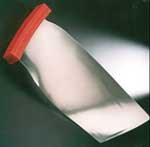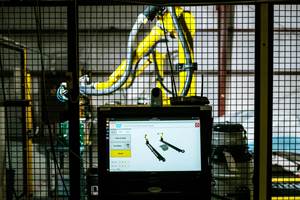Finished Parts Fly High
Mass finishing methods for aircraft components
In recent years, discussion of surface treatment and surface finishing for aircraft components-whether engine parts such as airfoils or airframe components-has been focused on improving fatigue life by inducing residual compressive stresses via various types of peening methods. Numerous articles have been written and technical presentations delivered on the subject of shot peening and, more recently, “laser peening.” However, very little has been said about the use of mass finishing technologies for the surface improvement of aerospace components.
Many aerospace manufacturers, as well as aircraft and engine maintenance and repair organizations (MROs), pay little attention to mass finishing methods. They consider that these “low-tech” tumbling solutions are dirty and noisy, and cannot contribute anything to component value.
How wrong they are! Mass finishing has evolved into a technology which covers a wide range of surface finishing applications and contributes significantly to improving component fatigue life, reducing component weight and improving overall fuel efficiency. This article will attempt to set the record straight by providing a brief overview of the numerous mass finishing applications for aircraft components that are being successfully used around the world.
Multiple Functions
Mass finishing--whether for aircraft components or any other parts--is a multi-functional technology. It is not only used for deburring or edge radiusing but also for surface smoothing and finishing on a wide array of aircraft parts. Deburring and edge radiusing reduce the likelihood of stress cracks in components, and smoothing and polishing surfaces of parts such as turbine airfoils reduces air flow resistance and improves fuel efficiency as measured by specific fuel consumption, which calculates the amount of fuel needed to maintain a specific power for a specified period of time.
Smoother surfaces also reduce the risk of deposits sticking to the airfoil surface. Smoother airfoil surfaces result in lower engine operating temperatures, allowing a greater margin between the actual exhaust gas temperature and the engine “red line”--maximum exhaust gas temperature (MEGT). This temperature reduction lengthens the time that an engine can remain in service before it requires overhaul and repair.
Special Considerations
Considering the sensitivity of aircraft components with regard to potential material loss as well as loss of life, their manufacture, surface treatment and surface finishing is subject to numerous stringent process and quality control procedures, including Nadcap and U.S. Federal Aviation Administration (FAA) regulations. (Formerly the National Aerospace and Defence Contractors Accreditation Program, Nadcap is now a global cooperative standards program for aerospace and related manufacturing.--Ed.)
In light of these stringent quality requirements, it should come as no surprise that manual finishing processes are about to be banned. The finishing process must be absolutely repeatable and completely documented. This requires a high degree of mechanization and, preferably, automation with very little or no human process intervention.
There are other requirements as well. Frequently, part-on-part contact during finishing must be eliminated to prevent nicking or damage. For this reason, many parts must be individually fixtured. The finishing process must produce consistently high surface quality within very narrow quality tolerances.
The selected finishing process must remove minimal material quantities to prevent or minimize costly weld repairs. In some cases the maximum permissible material removal is 0.0005 inch (<13 μm).
Of course, all these requirements apply to both new components and parts that require regular overhaul.
Airframe Components
Examples of mass finishing for aircraft components outlined in this section include a variety of airframe components and turbine components produced from aluminum alloys, titanium alloys and other materials. They also cover several different mass finishing processes.
Large structural fuselage sections and wing spars are produced mainly from aluminum alloys. The objective of mass finishing for these parts is to accomplish deburring and edge radiusing after machining. Parts free from burrs and with smooth radii as opposed to sharp edges have higher resistance to fatigue crack initiation and propagation. Paint adhesion is also improved, especially on part edges. Such components can be finished using large, high-speed tub or linear flow continuous vibrators.
Integral airframe components machined from aluminum alloys speed aircraft construction by combining what may have been several parts into one component. This approach minimizes assembly time and eliminates potential failure points at riveted joints.
One such component, a part 150 inch long ×12 inch wide × 1 inch deep, was processed in a special tub mass finishing machine. The Rosler type R 650/4000 TU vibrator used polyester plastic media, producing the required finish in a processing time of 18–20 min.
Turbine Components
In the engine compartment, titanium alloy engine casings required deburring after machining. For large casings, the mass finishing solution was a special circular vibrator without an inner dome. Smaller casings can be processed using a rotary plunge finisher.
In one case, parts with 58-in. outside diameter and 30-inch high were finished in a Rosler rotary vibrator without an inner dome. The machine featured a usable volume of 30 cu ft, and could be processed using either ceramic or polyester media.
Mass finishing is also applicable for turbine blisks and vane rings. Produced from nickel-based superalloys, these components required surface smoothing to an average surface roughness (Ra) of 4.8 μ inch after machining. The finishing solution developed by our company used a special circular vibrator without an inner dome.
The machine could handle parts to 32-inch diameter. Components were fixtured onto the bottom of the vibratory bowl and processed using ceramic media.
In another application, cast titanium alloy wide-chord fan blades required super-finishing after milling; the specified surface finish requirement was Ra <10 μin. The process developed by our company featured a dual-drive tub vibrator running our Keramo-Finish combined paste and ceramic media. Parts can either be allowed to free tumble in the tub vibrator or can be mounted on special fixtures.
In one application of this technology, wide-chord fan blades up to 40 inch long and 15 inch wide are processed in a machine with individual compartments. A single part “free tumbles” in each compartment with combined paste and ceramic media. Processing time for new blades is seven hours; refurbished blades can be finished in three hours.
Forged turbine compressor blades produced from nickel and titanium alloys require descaling and surface smoothing to Ra <20 μin. after forging and heat treatment, then super-finishing after machining. For relatively small components (up to 8 in. in length), descaling and smoothing occurs in high-energy disk finishing machines using high-cut ceramic media. Processing times can run up to 90 min. Larger blades are initially processed in high-speed rotary vibrators. Both of these technologies are in use at many engine OEMs and repair shops.
Super-finishing for these components involves fine grinding in rotary vibrators with special ceramic media, followed by our proprietary Keramo-Finish process using special ceramic media. Processing requires 6–7 hrs, and final part surface finish meets the required roughness specification of Ra <10 μinch.
High-alloy steel turbine disks require deburring and edge radiusing of the dovetail slots after machining and broaching. For parts to 30 in. diameter, our company developed a reciprocating spindle finishing machine with an integrated media classification system. One or two parts mount onto the spindle and are processed using aluminum oxide media for 30-40 min.
Worthy of note is this machine’s continuous media classification system, which automatically removes undersize particles from the media to guarantee repeatable finishing results. Spindle finishers without media classification tend to produce increasingly poorer finishing results as the abrasive media wears and becomes smaller. Over time, this can result in out-of-spec parts which must be scrapped. The entire batch of media is usually scrapped as well, even though large portions might still be usable. Continuous automatic media classification eliminates these problems.
Other Applications
Potential uses for mass finishing of aerospace components are not limited to parts for fixed-wing aircraft. Helicopter transmission gears manufactured from high-alloy steel, for example, require deburring, slight edge breaking and surface smoothing to improve fatigue life and reduce running noise.
In order to accomplish these finishing objectives, our company developed a special “drag” finishing machine with multiple rotating workstations. Parts to eight inch OD are specially mounted onto the work stations to avoid part-on-part contact. Ceramic media and a total processing time of 15 min provides slight edge radiusing and produces the required Ra of 10 μinch.
More Technologies
The above are just a few examples of practical, every-day applications of mass finishing technologies for surface finishing of aircraft parts. There are other technical developments which go hand-in-hand with improving the overall component life. Two examples are isotropic super-finishing (ISF) and vibro-peening.
ISF was developed as a potential replacement for shot peening, a process commonly used to induce compressive residual stress into the surface of a component. However, shot peening can sometimes also produce surface roughening and can even initiate micro-cracks, which may lead to fatigue and/or corrosion.
For these reasons, shot peening is frequently complemented by ISF, a super-finishing process with active chemistry. ISF smoothes the surface and removes the micro-cracks, thus eliminating the potential dangers outlined above.
Vibro-peening is a potential replacement for vibratory finishing processes using steel media. Use of steel media for vibratory finishing--commonly known as “ball burnishing” or “pressure deburring”--has been practiced for decades. The advantage is obvious: no or only very slow wear of the media. The disadvantage stems from the weight of the steel media (308 lb/cu ft), which places a big burden on the finishing equipment, especially the drive bearings and the bowl weldment. For this reason, ball burnishing is usually done in relatively small bowls at low amplitudes and low speed.
Recent technical improvements in bearing technology and welding stress relief methods, however, have helped to overcome these limitations and led to the development of high-speed vibrators that can handle steel media at higher amplitudes and speeds. Such high-energy, high-speed ball burnishing systems generate a peening effect on the processed parts. The residual compressive stresses generated with this vibro-peening method may be relatively low, but the process offers the distinct advantage of not only preventing but even closing micro-cracks and, thus, improving component fatigue life.
We would like to conclude with one last word regarding automation: it is amazing how many finishing processes--even in aerospace applications--still involve hand work, with all the resulting quality inconsistencies and variations. It is not surprising that the FAA appears to be determined to ban manual finishing processes in civil aviation finishing applications. For this reason, any mass finishing system destined for use in aerospace applications should include automated material handling, process control and process documentation capabilities.
Related Content
AI-Powered Robotic Solutions Support High-Mix Finishing
AI startup offers automation innovations for high-mix, high-variability, manual surface finishing applications.
Read MoreRobot-Ready Grinding Systems for High-Speed Production
Advanced rotary surface grinders now come “robot-ready” to facilitate integration with third party robotic arms and fully automate the process from loading to unloading.
Read MoreWall Colmonoy Hires Business Development Manager, Surfacing Products
Wall Colmonoy welcomes Josh Gardner as its business development manager of surfacing products.
Read MoreModernizing Wastewater Treatment and Recovery
Source: Kontek Kontek’s “spigot to drain” Source Water and Wastewater Solutions offer integrated technologies to modernize your water & wastewater treatment and recovery.
Read MoreRead Next
Delivering Increased Benefits to Greenhouse Films
Baystar's Borstar technology is helping customers deliver better, more reliable production methods to greenhouse agriculture.
Read MoreEducation Bringing Cleaning to Machining
Debuting new speakers and cleaning technology content during this half-day workshop co-located with IMTS 2024.
Read MoreEpisode 45: An Interview with Chandler Mancuso, MacDermid Envio Solutions
Chandler Mancuso, technical director with MacDermid Envio discusses updating your wastewater treatment system and implementing materials recycling solutions to increase efficiencies, control costs and reduce environmental impact.
Read More












.jpg;maxWidth=300;quality=90)












